A cow can live for around 20 years, she can give birth from 2-3 years old. When a calf is born it is taken away from the barrier after only a few hours of life. It is done to ensure that the mother and calf do not become too attached to each other, as this will make the weaning process and the separation process very stressful for both the animals and the stock keeper. If calves were left with their mother, they would suckle from her for several months, sometimes up to a year.
If the calf is male there are many possible options for its future: it can be castrated and raised as a steer; kept entire and used for future breeding (only healthy, well-born calves are used for this); or used for as a source of semen for Artificial Insemination (AI) programmes (only the a small percentage of the best, usually pure bred, bull calves are used for this process).
In the case of a female calf, the calf can either be raised as a replacement milker for the main milking swarm or raised on behalf of a buyer who will buy the calf when it is of proper age and weight.
Post-Birth Period to Weaning
After being removed from the dam, a calf (In the case of a female calf) will be fed milk or milk replacer until 6-8 weeks of age. This age is known as weaning age, at which the calf will be transferred onto a milk-free diet, consisting of high-energy and concentrated nutritional feed as well as forages found on grassland, in order to tone the physiology of the calf into a milk-producing vessel. Approximately one week of age, calves should be offered starter feed which will prepare it for weaning from milk.
Prior to weaning, calves are dehorned, vaccinated have extra teats removed and some male calves are castrated.
Breeding Period
The calf, which is known as a heifer (a female cow before it has calved, usually less than 2 years of age) is raised until it reaches suitable reproductive age which is around 15 months of age. If the calf has not reached a target weight, then it will be left to grow a little longer, in some cases the calf reaches target weight earlier and so is put into calf slightly earlier.
It is necessary to mate a heifer (young female cow) with a bull (mature male cow) in order for her to become pregnant and consequently start producing milk. To maintain maximum milk production a female cow must calve once a year.
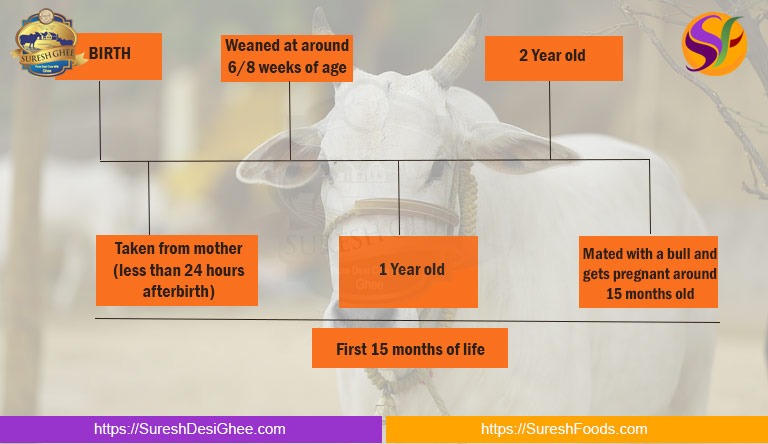
Gestation and Parturition
If the heifer was put in calf at 15 months of age, she should calf at around 23 – 24 months of age. So the period of gestation (pregnancy) lasts around 9 months. During this period the heifer will continue to grow and develop, however will not reach full size until around 4 years of age.

When the heifer has delivered her calf, her milk production will have started in order to provide colostrum in order to maintain the health of her calf. At this point, calf is taken away from her and she is milked to maximum capacity.

Read our blog Why The Pure Desi Cow Milk Ghee Is Costlier Than Normal Ghee? https://sureshdesighee.com/blog/pure-ghee-price-cow-ghee-online-shopping-1kg-ghee-price/

Milking Cow
The heifer (now known as a cow, as it has calved) will now start her period of milk production (lactation) which she would naturally do in order to feed her calf. This period lasts from the time of calving to the time of drying off; naturally, without human interference, it would last around 10-12 months but is usually forcibly stopped at around 10 months of lactation in order for the cow to go into a dry period before her next calf.
A cow can be ready to calf again around 3 weeks after giving birth and at every 3 weeks after this point (as this is when the cow is ‘in heat’). Normally it is aimed for cows to calve 12 months after from their parturition. If a cow is put back into calf at the earliest opportunity (around 1 month after a calf) then she will be dried off after only 7 months of the lactation period (which can last up to 12 months) meaning that production of milk is halted before time. To increase the milk production duration of the cow, the cow can be put into calf at around 2/3 months (around 50 days) after her previous calving date, which will expand the amount of time she can be milked for while she is still lactating.
I.e. 3 months after her calving, becomes pregnant again which will last nine months. 3 months of being milked + 9 months of gestation while being milked would give 12 months of possible milk produce duration, but the drying period must be taken into account, which is 2 months before calving. Therefore 10 months of milking can be achieved.
A dry period is when the cow is not milked and stops producing milk in order to give the cow’s body a rest and a chance to reconstruct and resynthesize in the milk producing machinery (udder and teat). It lasts for around 60 days and is very beneficial for the cow.
After this dry period of 60 days, the cow will calve again and the lactation cycle will begin again.
For cows, the period of 60 days prior to calving and 40 days after calving, it is known as the transition period. They make a transition between not being milked, to producing very high volumes of milk and to a high energy ration.
What is the difference between A2 Milk & A1 Milk type ?
The qualitative difference between A2 and A1 milk are the kinds of proteins found in it. Only Indian Cows and a few breeds of desi buffaloes produce A2 milk which is considered to be healthier for the human body. The A1 type of milk is not considered to be suitable for us as it is A1 beta-casein is inflammatory. Furthermore, ghee produced from A1 milk for such a reason makes it inferior when compared to the Ghee produced from A2 milk.
Is your ghee prepared from “A2-milk” type?
Ghee is produced from grass-fed cow milk that can be known as A2 (beta-casein) protein type rather than A1 (beta-casein) protein type which is the inflammatory agent causing adverse effects on consumption and has been highlighted to be potentially harmful to human health by some researchers. According to experts, the consumption of beta-casein A1 milk is determined as a risk factor for type-1 diabetes, coronary heart disease which when not digested easily causes a human’s body to develop an intolerance towards the milk.
What is organic ghee?
Ghee that is produced from milk obtained by purebred indigenous cows, like Gir or Red Sindhi, is usually known as organic ghee. Furthermore, as being purebred, such cows also require to be fed with grass grown without the use of fertilizers or pesticides which makes it chemical free. Also, the ghee must be made in the traditional methods following the four-step techniques to be considered organic.
How much milk do you need to produce 1kg of ghee?
In order to produce 1kg of ghee it requires about 30-40 liters of milk which means 15g of ghee consists of about 135 calories and 15g of fat as well as out of such 5g of fat, ghee contains of about 9g of saturated fat and the rest are monounsaturated and polyunsaturated fats.
Summary
- At 15 months of age, a heifer (young female cow) is ready to breed and does not produced milk before.
- A young female cow has her first calf at about 2 years of age. After the calf she is known as a cow.
- Once she has calved she starts her lactation cycle, which can last up to 12 months, but production of milk decrease after around 10 months of lactation.
- During the lactation cycle she is milked and during this period is also mated with a bull.
- 7 after months after mating, at around 60 days before calving (for the second time) she is put onto a dry period, at that time her lactation cycle ends and she is no longer being milked.
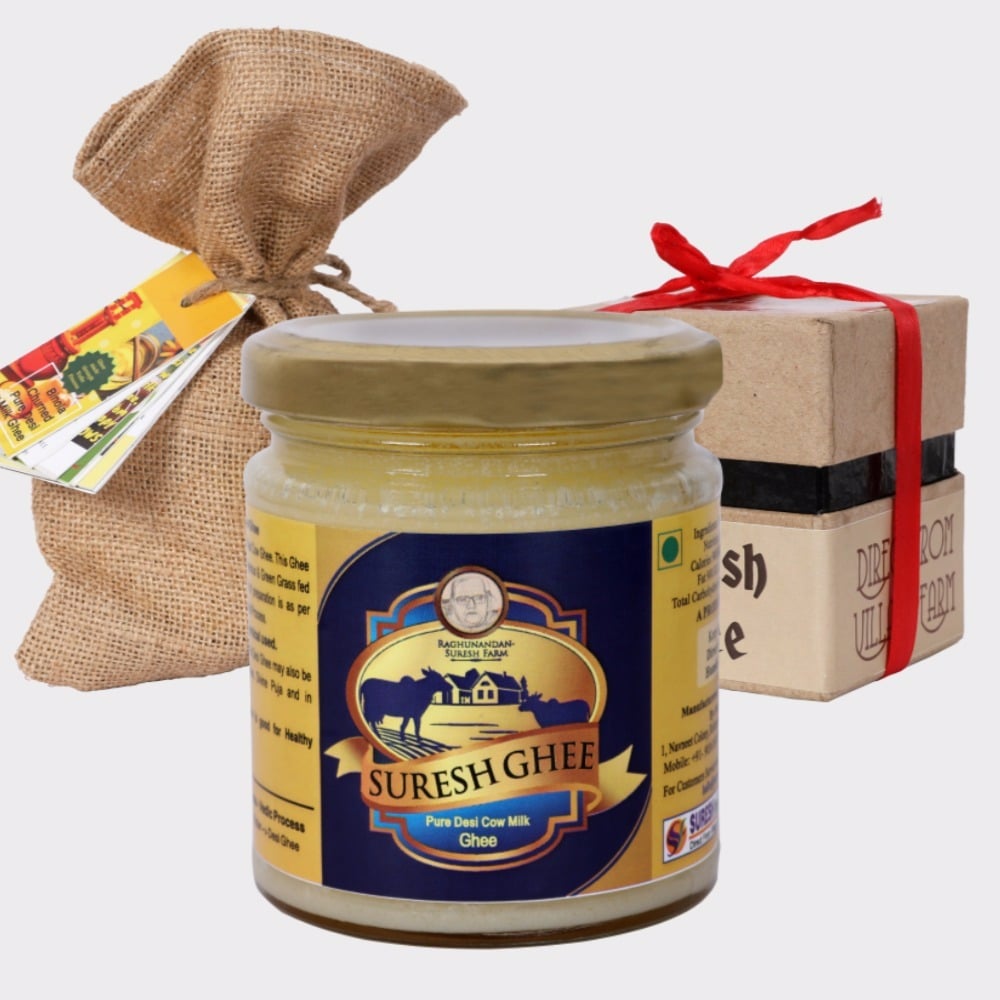
Buy Pure Desi Cow Ghee Online : Order Now. Free Shipping
Desi Cow Ghee Benefits
Pure Desi Ghee Price Online: 1 kg Ghee Price is Rs 2400/-
Health Benefits Of Drinking Milk With Ghee At Night
Desi Cow Ghee For Hair Growth, Hair Fall Treatment & Regrowth Benefits
Benefits Of Applying Desi Ghee For Face Overnight
Best Ghee For Babies, Infants Skin And Ghee Massage For Babies
Ghee For Mental Health
Desi Cow Ghee vs Buffalo Ghee vs Jersey Cow Ghee

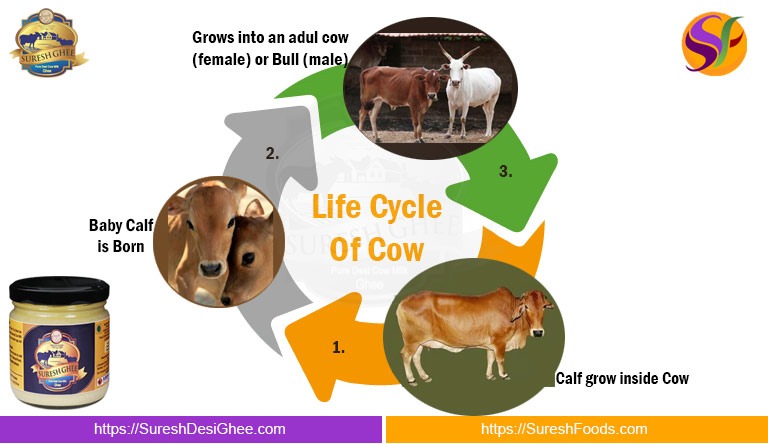
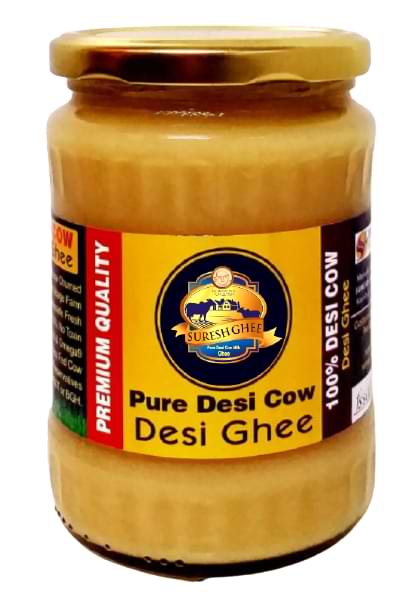

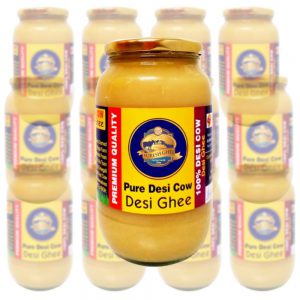
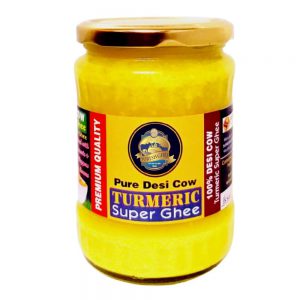
 WhatsApp us
WhatsApp us 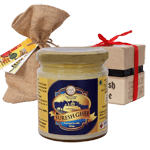
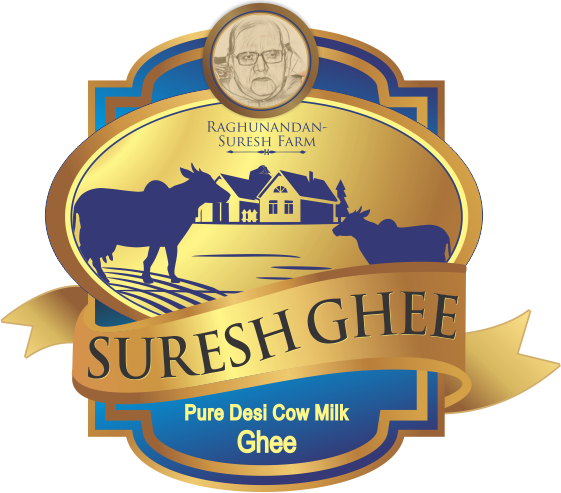
Naveen m...